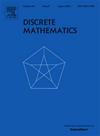On the two-distance embedding in real Euclidean space of coherent configuration of type (2,2;3)
IF 0.7
3区 数学
Q2 MATHEMATICS
引用次数: 0
Abstract
Finding the maximum cardinality of a 2-distance set in Euclidean space is a classical problem in geometry. Lisoněk in 1997 constructed a maximum 2-distance set in with 45 points. That 2-distance set constructed by Lisoněk has a distinguished structure of a coherent configuration of type and is embedded in two concentric spheres in . In this paper we study whether there exists any other similar embedding of a coherent configuration of type as a 2-distance set in , without assuming any restriction on the size of the set. We prove that there exists no such example other than that of Lisoněk. The key ideas of our proof are as follows: (i) study the geometry of the embedding of the coherent configuration in Euclidean spaces and to derive diophantine equations coming from this embedding. (ii) solve diophantine equations with certain additional conditions of integrality of some parameters of the combinatorial structure by using the method of auxiliary equations.
求助全文
约1分钟内获得全文
求助全文
来源期刊

Discrete Mathematics
数学-数学
CiteScore
1.50
自引率
12.50%
发文量
424
审稿时长
6 months
期刊介绍:
Discrete Mathematics provides a common forum for significant research in many areas of discrete mathematics and combinatorics. Among the fields covered by Discrete Mathematics are graph and hypergraph theory, enumeration, coding theory, block designs, the combinatorics of partially ordered sets, extremal set theory, matroid theory, algebraic combinatorics, discrete geometry, matrices, and discrete probability theory.
Items in the journal include research articles (Contributions or Notes, depending on length) and survey/expository articles (Perspectives). Efforts are made to process the submission of Notes (short articles) quickly. The Perspectives section features expository articles accessible to a broad audience that cast new light or present unifying points of view on well-known or insufficiently-known topics.
 求助内容:
求助内容: 应助结果提醒方式:
应助结果提醒方式:


